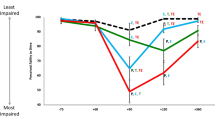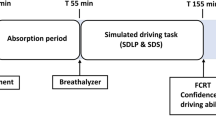Summary
The Transport and Road Research Laboratory has been concerned for a long time with possible causes of driving difficulties and has developed methods for investigating driving performance. The question addressed here was how applicable these methods are in assessing driving problems arising from the use of drugs which can impair performance, particularly widely-available centrally-acting drugs.
We assessed four types of driving-related tests by comparing their sensitivities with two laboratory tests, developed elsewhere, which measure more basic effects of drugs on performance, using drugs known to impair skills. Performances under the influences of ethanol, the benzodiazepine lorazepam, and the antihistamine triprolidine, each given both as a single high dose and a single low dose, were compared with performances after placebo. We used double-blind crossover design, in which subj ect variability was minimized by studying only women of a limited age range (45–55 y).
The driving-related tests detected the effects of the substances used, although they were generally less sensitive than the laboratory tests. The individual sensitivities of the driving test could be improved to match those used for more general assessments.
Similar content being viewed by others
References
Alsop RE (1966) Alcohol and road accidents. Transport and Road Research Laboratory, Report LIZ 6. Crowthorne, RG11 6AU, UK
Burns M, Moskowitz H (1980) Effects of diphenhydramine and alcohol on skills performance. Eur J Clin Pharmacol 17: 259–266
Borland RG, Nicholson AN (1974) Human performance after a barbiturate. Br J Clin Pharmacol 1: 209–215
Cohen AF, Hamilton M, Philipson R, Peck AW (1985) The acute effect of acrivastine a new antihistamine, compared with triprolidine on measures of central nervous system performance and subjective effects. Clin Pharmacol Ther 38: 381–386
Denton GG (1966) Moving road simulator- a machine suitable for the study of speed phenomena motion after-effect. Ergonomics 9: 517–520
Irving A (1988) A proposed investigation into drug impairment testing methodology. In: Burley D, Silverstone T (eds) Medicines and traffic safety. CNS (Clinical Neuroscience) Publishers, London
Seppala T, Korttila K, Hakkinen S, Linnoila M (1976) Residual effects and skills related to driving after a single oral administration of diazepam, medazepam or lorazepam. Br J Clin Pharmacol 3: 831–841
Moskowitz H, Sharma S, Ziedman K (1979) The effect of a single acute dose of diazepam on driving-related skills performance. Proc 23rd Conf AAAM. 277–289
O'Hanlon JF, Haak T, Blaauw GJ, Riemersma JBJ (1982) Diazepam impairs lateral position control in highway driving. Science 217: 79–81
O'Hanlon JF, Brookhuiss KA, Louwrens JW, Volkerts ER (1986) Performance testing as part of new drug registration. In: O'Hanlon JF, de Gier JJ (eds) Drugs and Driving. Taylor and Francis, London
O'Hanlon JF (1988) Are actual driving tests necessary for evaluating drug safety? In: Burley D, Silverstone T (eds) Medicines and Road Traffic Safety. CNS (Clinical Neuroscience) Publishers, London
Olch RJ, Hect SE (1979) Microcomputer graphics in psychological research. Behav Res Meth Inst 11: 119–126
Quimby AR, Maycock G, Carter ID, Dixon R, Wall JG (1986) Perceptual abilities of accident involved drivers. Research Report 27, Transport and road research laboratory, department of transport, Crowthorne, Berkshire UK
Smiley A, Ziedman K, Moskowitz H (1984) Drug and alcohol effect on steering measured in a driving simulator. Report submitted to the US National Institute on Drug Abuse, Contract No. SSN 56451-5145
Willette RA, Walsh M (1983) Drugs driving and traffic safety Offset Publication 78, WHO, Geneva, Switzerland
Winer BJ (1962) Statistical principles in experimental design. McGraw-Hill, New York
Author information
Authors and Affiliations
Rights and permissions
About this article
Cite this article
Irving, A., Jones, W. Methods for testing impairment of driving due to drugs. Eur J Clin Pharmacol 43, 61–66 (1992). https://doi.org/10.1007/BF02280756
Received:
Accepted:
Issue Date:
DOI: https://doi.org/10.1007/BF02280756




